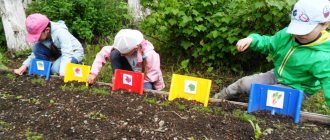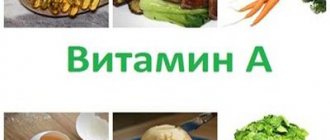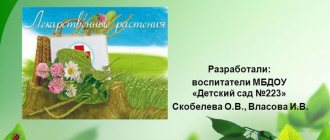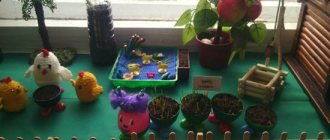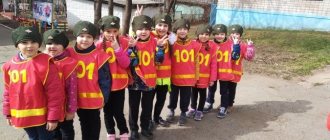MAGAZINE Preschooler.RF
Project “Journey to the World of Ants”Fedotova Lyubov Sergeevna teacher of MBDOU "Kindergarten No. 399" g.o. Samara.
Relevance of the project
The problem of environmental education is one of the fundamental problems of the theory of education and is of paramount importance for educational work. Educators of the last century attached great importance to nature as a means of educating children. So, Ya.I. Comenius saw in nature a source of knowledge, a means for the development of the mind, feelings and will.
In modern conditions, with the expansion of the scope of educational influence, the problem of environmental education is especially relevant. With the adoption of the laws of the Russian Federation “On Environmental Protection” and “On Education in the Russian Federation” , the prerequisites for the legal framework were created for the formation of a system of continuous environmental education, the first link of which is preschool education. Therefore, environmental education of the younger generation is one of the most important tasks of the entire public education system.
Preschool age is the most favorable period for a child’s emotional interaction with nature. This entails the task of developing a responsible attitude towards nature in children. And the sooner work on environmental education begins, the greater its pedagogical effectiveness will be.
Thus, preschool children, learning about the world around them and encountering the world of insects, react differently. Some are afraid of insects, others destroy them because they know little about the benefits of insects. This is explained by the fact that interest in the surrounding nature was not supported in time and, on the basis of a healthy interest, they were not introduced to the life of insects. Children cannot independently explain natural phenomena of interest, so this is the task of adults.
Observation is the main means of understanding nature. It makes it possible to introduce children to natural phenomena and the relationship between living and inanimate nature. It is observation that helps preschoolers see the changes that occur in plants depending on environmental conditions or those created by man. As a result of observation, children learn to analyze and compare.
While walking, the children saw an ant. The guys' reaction was mixed. Some children expressed joy and interest, others were scared. There were also guys who suggested destroying it. Opinions were divided. During the conversation, it became clear that knowledge about insects is scarce. Thus, the problem arose : “Are ants necessary? Do they bring benefit or harm? . Children's participation in the project allowed them to form ideas about insects, their benefits or harm, and develop creative abilities and search activities.
Goals and objectives of the work performed
Goal: developing ideas about the life of insects.
Tasks:
- To form in children elementary ideas about ants, their structure, and methods of movement.
- Foster a caring attitude towards living things and an interest in insects.
- Develop emotional responsiveness.
- Develop research skills.
Forms, methods of work, results
Working with parents on the project
Consultation “How to instill a love for nature”
Providing assistance in the selection of encyclopedias, literature, games.
Observation of ants with parents in different places and at different times.
Project products:
- Ant (modeling)
- Anthill (drawing)
Project portfolio
- Ecological album “Journey to the world of ants”
Expected result of the project:
For children:
- Children's caring attitude towards nature, in particular towards ants
- Development of cognitive activity and curiosity
For teachers:
- Development of children's communication skills, ability to work in a team
- Creating conditions for imagination
Expanding children's horizons through reading fiction, becoming familiar with proverbs, and learning poems.
For parents:
Joint reading of fiction about ants, watching the cartoon “How the Ant Hurried Home”
Involvement in cooperation to create conditions for children's cognitive and research interests
Stage I - Preparatory
- Diagnosis of ecological knowledge of ant insects.
- Selection of encyclopedias, magazines, literary works, illustrative material about insects, ants.
- Selection of didactic games (lotto, puzzles), toys and attributes for gaming activities.
- Drawing up a plan for the main stage.
Stage II - Main (project implementation)
1. Educational conversations on the topic
Purpose: to introduce the names of the parts of the ant’s body, to introduce them to the methods of nutrition, lifestyle, benefits or harms and significance for the lives of other inhabitants of nature.
2. Literary word, riddles about the ant, reading a fairy tale and watching the cartoon by V. Bianchi “How the ant hurried home . Reading I. Krylov’s fable “The Dragonfly and the Ant” .
Goal: to introduce children to literary works about the ant.
3. Walk “Observing ants” (searching for an anthill: observing insects on a walk, examining body parts through a magnifying glass).
Goal: consolidate knowledge about the ant’s home, how to protect anthills
4. GCD “From the life of ants”
Goal: consolidate and clarify children’s knowledge about the lifestyle of ants, habits, benefits, activate children’s vocabulary
5. Art activity “Who helped the ant get home” , “Anthill” , “Ant” (modeling).
Goal: To strengthen children’s visual skills by depicting an ant.
6. Game - dramatization based on the fairy tale by V. Bianchi “How an ant hurried home”
Goal: to consolidate children’s knowledge about the content of a fairy tale, develop speech,
artistic abilities.
7. Watching the cartoon “Dragonfly and the Ant”
8. Outdoor games “Bear and bees” , “Day and night” , “Ant and rain” .
III productive stage
Making an environmental album
Exhibition of creative works
conclusions
After conducting research, observing the life of ants, we learned who ants are, what the living conditions are, what anthills are built from, what functions each ant performs, what species exist, what is its role in nature. This gave the children a desire to communicate with nature.
Children learned to understand the need to take care of nature. Ants are a vivid example of hard work and mutual assistance. They are interesting for their complex social behavior. Ants know how to build, find water, give signals to each other, navigate by the sun, but they do not know how to live alone, like any person. So there was a desire to get more information about ants and other insects.
The importance of ants in nature is great. Therefore, it is necessary to protect and protect.
Literature:
- Alekseev V.A. “300 questions and answers on ecology” , Yaroslavl. -1998
- Alyabyeva E.A. “Thematic days and weeks in kindergarten” , Moscow 2008.
- Baranov, V. S. Research work in preschool educational institutions / V. S. Baranov // Preschool education. – 2009. – No. 4. – P. 23 – 24.
- Baulina, Yu. V. Observations in kindergarten / Yu. V. Baulina // Preschool education. – 2008. – No. 7. – P. 30 – 31.
- Zolotova E.I. “Introducing preschoolers to the natural world” , Moscow. — 1992
- The main general educational program of preschool education FROM BIRTH TO SCHOOL. Under. ed. Veraksy N.E., Komarova T. S., Vasilyeva M. A. – M., Mozaika – Synthesis, 2015
- Pichugina, N. O. Preschool pedagogy. Lecture notes / N. O. Pichugina. – Rostov n/d: Phoenix, 2004. – 384 p.
- Innovative orientation of a modern preschool educational institution / V. N. Abushaeva // Preschool education. – 2006. – No. 5. – P. 23 – 24.
- Shorygina T.A. Insects. What are they? M.: “GNOM and D” -2005.
- Coloring book Ant [Electronic resource]
| Next > |
Research paper “Are ants intelligent?”
Ants are amazing creatures! Tiny insects, but so strong, hardworking and persistent! Ants live close to us, but have we studied them well enough? Do we know everything about them? I became interested in ants when I discovered an anthill near my grandmother's house. I began to observe the life of ants, feed them, and conduct various experiments. And this is what I discovered. It turned out that the anthill is an entire city, or even a state. In it, every resident is busy with his own business. Real roads lead to the anthill, and inside it there are various passages - communications. An anthill lives as a single organism. When an ant finds food, it does not eat it alone, but tries to deliver it to the anthill. If one ant cannot do this, his comrades help him. Ants always work together. Try to disturb an anthill - the ants immediately rush to its defense! At the same time, their main concern is to quickly transfer and hide their offspring. I thought: if ants know how to build roads and cities, if they are always busy with a common task and communicate with each other, maybe they are intelligent? And so I decided to look into this issue.
The life of the ant community became the object of my research.
The relevance of the study lies in the fact that currently people, with the help of machines, are increasingly destroying the ecology of our planet, not paying attention to the unique systems and communities that exist next to them, not noticing such small neighbors as ants. It is necessary to draw attention to further study of the species living on Earth and increase human responsibility for their conservation.
hypothesis : ants have the qualities of intelligent beings.
The goal of the project: to establish signs of intelligent behavior in ants.
Tasks:
- study specialized literature on the chosen topic;
- carry out constant monitoring of the research object;
- conduct experiments aimed at identifying the behavioral characteristics of ants;
- collect additional information from available sources: television, Internet, direct communication.
While working on the project, I learned a lot of interesting and amazing things about ants.
As a result of my research, I came to the following conclusions:
- Ants are insects that live in complexly organized communities that obey their own laws.
- Ants have good memory, the ability to learn, and can transmit information to each other.
- Ants are intelligent! But this is not the mind of each individual creature, but the collective mind of the ant community.
- It is the collective mind that helps ants survive, adapt to any conditions, and preserve their civilization. And this intelligent civilization does not exist somewhere in outer space, but on the same planet as us!
project "Ants"
Subject: "
Ants are familiar strangers.”
Target:
study the structural features and behavior of ants
Novelty
research work consists of studying the life activity of an ant colony in the process of performing practical research
The work used theoretical and practical methods: analysis and classification of material from various sources, conducting simple experiments
Practical meaning:
The material presented in the work may be of interest to school students.
I did not choose the topic of my work by chance; I was very interested in the most famous social insects - ants.
I. Introduction
I first became interested in ants when I was 5 years old. Then I observed them on the street near the house, examined them under a magnifying glass, and I began to wonder what kind of insects these were?
Target:
study the structural features and behavior of ants
It turned out that ants are one of the most famous insects. Among the order of Hymenoptera there are no single ants at all. The majority of the family consists of working individuals - sterile females, lacking wings. They perform all the necessary work in the nest: build and clean it, get food, take care of the offspring. The caste of soldiers guarding the nest consists of ants with large heads and powerful jaws. All members of the family are the offspring of the founder female.
This work made it possible to study the life activity of ants based on observations and experiments.
II. Ants – familiar strangers
1. Types of ants.
There are more than twelve thousand species of ants, but I will list the species that are more familiar to all of us and tell a little about each species.
Red forest ants
.
Red forest ants are one of the most important protectors of forests from pests, as they consume a huge number of all kinds of insects.
Messor Structor - or reapers
.
Reapers consume plant seeds as food. Nests in the soil are up to several meters deep and can serve as indicators of groundwater. Reaper ants store seeds in deep chambers.
Lasius Nigger – чёрный садовый муравей
The well-known black garden ant consumes seeds and other insects as food.
Faron ant – (house ant)
The pharaoh ant reaches a length of only two millimeters. Its color is red, widely known as the “house ant” that inhabits human homes. It is one of the most famous household pests.
2. Anthill structure
Anthills come in different types: underground, domed, woody.
2.1. Dome anthills
The dome anthill is very complex. The anthill dome, built from twigs and pine needles, can reach two meters in height and three meters in diameter. The surface of the dome is riddled with numerous entrances, which are opened and closed by ants depending on the time of day and weather. The underground part of the nest, where the family overwinters and the chambers with food reserves are located, is located under the dome and goes to a depth of up to a meter.
In an individual research project in biology on the topic “Ants at home,” the student studied the theory of keeping ants at home, transferred ants from a test tube to a formicarium, and observed their behavior in different conditions.
More details about the work:
During the student research work on biology “Ants at home”, the influence of the habitat and feeding method on the life activity of ants and the development of the colony in a formicarium was examined.
An educational project in biology on the topic “Ants at home” contains information about favorable conditions for the life of ants and proper feeding of insects in a home formicarium; an observation and experiment was carried out on the interaction of harvester ants with ants of other species and other insects.
The materials of the research project can be used as an additional resource in preparation for biology lessons, as well as for independent study on the topic for the purpose of self-education and broadening one’s horizons in the field of biology and entomology.
Table of contents
Introduction 1. Who are ants? 2. Reaper ant at home. Conclusion References
Introduction
I love insects. I noticed that they surround us everywhere. In the summer at my grandmother's, I look with interest at all the insects that catch my eye. The most interesting thing is to look at the ants. Because they run and scurry tirelessly back and forth, constantly doing some kind of work. As soon as their anthill is touched and slightly damaged, vigorous work immediately begins to repair and strengthen their home. There are stones near grandma's house, and under them there are anthills.
My brother and I moved the stone a little and panic began and at the very top of the anthill there was almost not a single ant left. Then I noticed that we had red ants running around in the bathroom at home. Parents say that ants are pests in the home because they steal food and can carry some diseases. I don’t see them anywhere except this room, so I concluded: they live there because it’s humid.
These ants are also very small. Last year they were disinfected and they disappeared, but a year later they began to appear again. I began to wonder where their home is, how they spend the winter. I wanted to learn more about them: how the ant family works, do ants sleep, how do they breathe, what do they eat, what is tropholaxis , do ants hibernate in winter, who is the queen, why is the size of the queen so large, why are the sizes of ants in one anthill different, why some have wings and others don’t, how offspring appear and much more.
I asked my mom and dad to buy me an ant farm . And they gladly bought it for me.
Relevance of the chosen topic: the opportunity to observe and study the behavior of insects at home.
a goal for myself : to develop a colony of ants.
To do this, it is necessary to solve the following problems:
- study the literature on this issue;
- move ants from a test tube to a formicarium;
- provide favorable living conditions for ants and proper feeding;
- conduct observation and experiment;
- draw conclusions.
Object of study: ants.
Subject of research: formicarium.
Purpose of the work: to populate the ants in the formicarium, observe the behavior of the ants and increase the number of individuals in the colony.
Methods and techniques:
- studying literature, Internet sources and summarizing the information received;
- creating favorable conditions for the development of the colony;
- observation of the behavior and life of ants in a formicarium;
- conducting an experiment.
Data obtained: based on the data obtained, I was able to organize the life and development of ants in a formicarium.
Conclusions: the colony is developing, the research can be considered successful.
Go to section: 2. Who are ants?
Progress of the game: One driver is an elephant, the rest are ants.
Elephant: “Let the ants walk and dance from the heart .”
Children dance as they please.
Elephant: " The ants ,
I'm tired of them.
The elephant went for a walk
Trample ants!»
The ants scatter , the elephant tries to catch them - to touch the ant . From those who were not caught, a leading elephant is chosen using a counting rhyme.
Target walk " Ants "
Goal: expand children's understanding of ants - workers ; expand your vocabulary; cultivate a caring attitude towards insects;
Research project “Anthill Life”
Purpose of the work : protect anthills from destruction.
Project characteristics:
by dominant activity - social research, with elements of creative activity of students; in the subject area – natural science using interdisciplinary integration (music, visual arts); by the nature of contacts between project participants - intergroup; by duration – long-term (one month); type of presentation - role-playing game: product - an action to protect anthills, with the creation of a sign informing about the location of anthills, information posters about the benefits of ants and the need to treat them with care.
Social research tasks:
- Find out as much as possible about the life of ants (conduct observations, experiments).
- Involve all preschool children in the secrets of the life of ants.
- Organize and carry out an action to protect anthills.
Research methods and tools:
- Observation.
- Experiment.
- Analysis.
- Generalization.
Tools used:
1. Methodological, artistic, educational literature.
2. Visual aids for offices. Equipment: film about the forest, appropriate design of the ecological trail, anthill, ants, route sheets, cards - sources of information; cards for organizing collaboration in groups; materials for constructing ants, anthills, relevant fiction and scientific literature; illustrations, musical accompaniment, signal cards, creative newspapers for pupils of senior groups.
Preliminary work (work in the “Ecological Trail” system of activities): conversations, games, looking at illustrations, dummies, learning poems about nature, excursions, making crafts.
Those present: pupils of the preparatory group, teachers of preschool educational institutions, parents of pupils.
Progress of the lesson
35 minutes
Organizing time.
Classes take place in an ecological zone. There is a spring forest on the screen. Children set off on another journey along an ecological trail using route sheets (a sheet of a certain color, the commander is an “asterisk”. Stop “Anthill”).
Introductory part.
Leading. Hello guys, adults, guests. Today we continue our journey along the ecological trail. We learned a lot of interesting things about autumn and winter natural phenomena. We admired the beauty of nature, learned to protect and enhance it. And finally spring has come to Yamal! What changes in nature have you noticed (listing)?
Ant. (An ant jumps out onto the path crying.) Trouble! Trouble! Help! Save!
Leading. Who is this? What's happened? Let's see?
Children. (They approach the anthill. They examine it). The anthill is ruined. Ants are in trouble. They are fussing. They run around their home.
Leading. How could this happen? Who did it? (Strictly, addresses the children).
Children. (Confused). This is not us. Possible answers: We don't know how it happened. This is a bear. Who else could have done this?
Main part.
Leading. Do you feel sorry for the ants? Want to know how to help them? How to save them?
Leading. To do this, we need to learn as much as possible about ants. How to do it? Let's draw up a work plan.
Work plan (proposed by children):
- Get acquainted with available research sources:
- Think for yourself.
- Get acquainted with books together with the teacher and parents about what you are researching (library).
- Ask other people (medical office, children's creative laboratory, music room, art studio).
- Get acquainted with films and television films on the topic of your research.
- Observe (excursion).
- To conduct an experiment.
Contents of project activities
Leading. Think for yourself. What questions would we like answered? What do we want to know?
Theoretical part.
- Where do you live?
- How do ants build their anthill?
- What do ants look like?
- How does life work in a large ant commune?
- Who are your friends and who are your enemies? Interesting stories from the life of ants.
- What benefits do ants bring?
- Ants, we will save you.
Leading. Now let’s divide into groups and continue practical work (determine topics based on interests, divide children using colored cards - signals). Children go with their leaders to receive information on their interests and get to work (to the kindergarten library, medical office, music room, children's creative laboratory, fine arts studio).
Practical part 1. Defense of a social research project.
In the form of a role-playing game, the result of the research project “Anthill Life ” is presented: an action is organized to protect the “Anthill”,
- Speech by mini-group leaders (Appendix 1).
- Mini-group report on the work done (a story about how the idea of protecting ants arose, what difficulties there were in working on the project, what ideas were rejected, which ones were accepted and why, how difficulties were overcome (using photo and video materials).
- Asking questions by listeners. Responses from project participants.
- Organizing an action to protect an anthill from destruction by people (analysis of all the ways to protect an anthill proposed by children, improving a sign to protect anthills, creating posters and leaflets on protecting anthills).
Sample conversation:
Host: You really learned a lot about the life of ants. Do you think there is anything we people can learn from them? How can we help them?
Sample answers from children:
Don't destroy anthills. Be quiet in the forest. Tell other children about the benefits that ants bring.
Offers:
- Create a sign “Attention, Anthill”, which warns about the presence of anthills in a given place and prohibits approaching close to them.
- Draping red ribbons around trees as a sign that there are anthills here means you need to be careful and attentive.
- Develop informational posters “Ants are strongmen!”, calling for people to be more attentive in the forest, remember the forest is the home of animals and plants, and you need to behave in it like a human being.
The result of the social research project for preschoolers is assessed by an expert group consisting of the deputy head for scientific and experimental work, the Minister of Children's Press, and a representative of the parent committee of the preschool educational institution).
Conclusion(s):
We believe that we learned a lot of interesting things about the life of ants, and were able to convince the children of the preschool educational institution that it is impossible to destroy anthills, and in general treat animals cruelly. We hope that making warning signs to protect anthills will once again make the children think about how important it is to be friends with nature, to be kinder and closer to it. During the research, we acquired important skills that will help us independently acquire new knowledge. But this is so interesting! We are confident that we have completed the main task of our work - none of the children living in our village, much less adults, will destroy an anthill, will not offend the little worker of nature, the strongest and at the same time completely defenseless animal in the world. light - an ant. And one more thing - during our work we learned a lot from the ants and became very friendly. We will continue our work on monitoring anthills, and perhaps we will be able to learn something previously unknown and unexplored.

